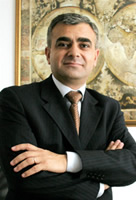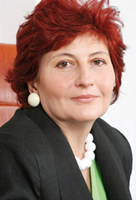Flight from financial collapse
Romania may be the last EU country in central and eastern Europe to introduce private pensions, but how successful will this new industry be in today’s uncertain financial world? Corina Mica asks main market players
|
 September witnessed the birth of a new industry in Romania, with legislation giving the green light to the much-awaited private pension system on the Romanian market.
September witnessed the birth of a new industry in Romania, with legislation giving the green light to the much-awaited private pension system on the Romanian market.
Optimists hope that through this legislation, in 30 years’ time, pensioners will lead a more decent life, as young people are forced to save earlier into pension accounts administered by private businesses.
But there are still many problems at this early stage. Private companies have complained about the low level of commissions they receive in comparison to other countries’ systems.
Some have called for better mediation to ensure that consumers have means to fight foul play, while questions are also raised about the quality of the IT systems in place.
At present, over 15 companies are managing pension funds – but this figure is likely to fall in the future. Experts believe at most ten funds will survive, as mediocre administrators go under or are subject to takeover. What happens to funds overseen by busted companies will also be a matter of consumer concern.
Calling time on state pension
The Romanian state introduced a pension system at the beginning of the 20th century, with money contributing to the system moving on to the existing pensioners. As a self-sufficient entity, this is now heading for collapse. Life expectancy has increased, which is good news for everyone except the welfare state, because the total number of pensioners will overtake those who can contribute to their pensions.
Many analysts argue that the failure of the state pension is because the system in which contributors pay to the social securities budget is inefficient. The state also does not, and cannot, invest the money it receives – which it then passes on straight to the current class of pensioners. Demographically, the number of contributors to the state pension is decreasing every year. Numbers of employees in Romania have fallen from over eight million in 1990 to under five million in 2006. If at the beginning of the 1990s there were five employees paying the pension of one retired person, this ratio now stands at one employee to 1.2 pensioners. In the next two decades, according to the National Institute of Statistics, the proportion of the elderly will rise from 14.3 per cent to 17.4 per cent of the population – the kind of shift all Europe has to contend with.
New deal
 All Romanian employees under the age of 35 have four months to chose to subscribe to one fund and then, most probably in March next year, the funds will start collecting money.
All Romanian employees under the age of 35 have four months to chose to subscribe to one fund and then, most probably in March next year, the funds will start collecting money.
“There are countries in western Europe which do not have this multi-pillar system in place, such as France, Spain and Italy,” says Mircea Oancea, president of the Commission to Supervise the Private Pensions System (CSSPP). “They deal with public pensions, which can be administrated by the state or by a private company, but they are public. In our case, Pillar III is a new addition, as it is a voluntary form of saving and investing. It is similar to joining an assetsmanagement company or life insurance policy.”
Romania’s legislation is based on the experience of New Europe and the principles are similar, but critics argue that its legislation is restrictive and prudent.
Oancea says that one good aspect of this law is that there are two distinct entities - the company that administrates the fund and the fund itself. This means that if the company looking after the fund goes bust, the state can interfere to protect the consumers. The state therefore acts as a guarantor for the fund.
“If anything goes wrong or rules are not respected, there are procedures in place to withdraw the authorisation or place a company under special supervision to protect the fund from the company’s problems,” says Oancea.
The fund itself will survive and could become a target for a takeover by a stronger company.
How it works
 All of the EU’s CEE countries have the private pensions system in place, with different contributions being levied from employees. When current employees become pensioners, they will be able to increase the amount they receive because there will be more sources of money available – one private and one public. The investment amounts and methods will be different for Pillars II and the voluntary pensions for the over-35s, Pillar III. Contributors should gain more money through the private system, because fund administrators invest the money and therefore the amounts should gain greater yields.
All of the EU’s CEE countries have the private pensions system in place, with different contributions being levied from employees. When current employees become pensioners, they will be able to increase the amount they receive because there will be more sources of money available – one private and one public. The investment amounts and methods will be different for Pillars II and the voluntary pensions for the over-35s, Pillar III. Contributors should gain more money through the private system, because fund administrators invest the money and therefore the amounts should gain greater yields.
“The transformation of the distribution system from pay-as-you-go is essential in the pension system evolution as, for the moment, the demographic evolution means there will be a higher pensioner to employee ratio,” says Marius Floarea, president of OTP Fond de Pensii.
Having started as a worldwide industry in Chile in 1981, private pensions have had a quarter of a century to settle and create market demand.
“It’s been a huge success in South America where people were forced to save and invest,” says Aviva CEO Shah Rouf. “Romania is second only to Poland in the EU’s central and eastern Europe and it will be a sizeable industry in ten years’ time if everything goes according to plan. This gives the benefit of stability from scratch in Romania.”
Pillar II has well-defined parameters, which sees employee contributions gradually increasing by 0.5 per cent of the gross salary every year until they reach six per cent. This is based on the individual management principle, which means that each employee is investing for their own pension, rather than the cash going to a pool of money which the individual has no ownership rights over. This gives the contributor the chance of knowing at every moment the amount of money they have accumulated.
“Having Pillar II, people will have an individual account that accumulates money for a pension,” says Mihai Coca-Cozma, director of AIG Fond de Pensii. “This will transform people into ‘investors’ and ‘owners’ of a major part of their pension.”
An imperfect system?
“Launching the first private pensions law is not an easy political decision to take,” says Damien Marechal, managing director of BRD Fond de Pensii. “It is extremely courageous, as we see an unbalanced public pension system. But the system may always be improved, and it is up to the population to request any changes if they so demand.”
There are gaps in the current legislation, argues Radu Vasilescu, general manager of ING Fond de Pensii.
The law sets a maximum level of commissions that a company may charge the contributor to manage a fund for mandatory and voluntary pensions, which at this point is an initial administration fee of 2.5 per cent and 0.05 per cent per month commission of total assets in one pension account. This is the lowest in Europe.
The decision has no basis, says Vasilescu. “The commissions are too low,” he says. “The law decided this by itself, without allowing the market to stabilise itself. Although these level of commissions are unheard of, they seem to be correct for the debut of the system.”
Aviva’s Shah Rouf also believes the low commissions are strange. “This is good for the customer but not that good for the company,” he says. Legislation may change, argues Coca-Cozma. “The level of contributions and the administrators’ commissions may be modified,” he says.
Too late in place
 “It is disadvantageous for the population that it was introduced so late in Romania,” says Ioan Vreme, general manager of Generali Fond de Pensii. “But it is good for the legislative process, as it could learn from the experience of other countries which reformed their pension system earlier. Through this move, Romanian pensioners [in 30 years] gain back the value of a pension.”
“It is disadvantageous for the population that it was introduced so late in Romania,” says Ioan Vreme, general manager of Generali Fond de Pensii. “But it is good for the legislative process, as it could learn from the experience of other countries which reformed their pension system earlier. Through this move, Romanian pensioners [in 30 years] gain back the value of a pension.”
But Vreme argues one absence in the law is that there is no mediator in place. It is illegal for a participant to sign with more than one company. But if a customer ends up joining four different private pension funds, for example, all those contracts become null and void. A customer has no way of appealing in such an unfortunate situation.
“The contributor is then automatically distributed to a fund, without having any choice,” adds Vreme.
Most market players believe that the money collecting system is not fully developed to function at best. “It needs improvement in order for things to be accordingly settled,” says Cristina Nitescu, general manager of Omniasig Pensii. “The electronic system, as well, is not ready to undertake its duty.”
Nor is this system that state-of-the-art. “We do not have the degree of sophistication of other countries’ IT systems,” says Vreme. “The gimmick of this market also lays in its capability to put into practice a good collection system. There are solutions. Efforts are being made to solve this problem.”
The target market is also restricted. “The age brackets for eligible people are very tight,” says AIG’s Coca-Cozma. “Why do we not allow people from 45 to 50 years old to catch the last train?
Although private firms have begun the hard-sell of their pension products in the media, there has also been no national public communication campaign by the regulator.
“There are technical aspects which need to be explained to all categories of population,” says Vreme. “People should understand very clearly that, even if their pensions are privately administrated, the state guarantees the money and supervises the investment procedures.”
For Vasilescu of ING Fond de Pensii, what is more painful is that those who the private pension system addresses are the most misinformed. “Nothing has been done to inform young people who are compelled by law to join one fund,” he says. “Companies have been forbidden by law to do anything before 17 September and authorities did nothing to counteract this lack of information. In the end, not knowing something generates fear and rejection, and huge discussions will derive from this lack of information.”
Unclear progress
 As the system is at the beginning of the implementation process, it is impossible to estimate which fund will perform best or how many young people will sign up in the next four months.
As the system is at the beginning of the implementation process, it is impossible to estimate which fund will perform best or how many young people will sign up in the next four months.
“Only after the first two years of activity of the private pensions funds, will we be able to compare yields,” says Nitescu.
But the Supervision Commissions has tough measures in place to keep the market under control. After two years of business, if a company does not reach a minimum threshold of effectiveness, it may lose its authorisation to manage a fund. This effectiveness is based on the market average of a fund’s profitability.
“No fund can perform below four per cent of the market average by law,” says CSSPP president Mircea Oancea. “The authorisation is automatically withdrawn if the profit is below the market average for four consecutive quarters.” The fund will then become the target of a takeover from another company.
Most players agree the market is likely to consolidate in up to five years. Now there are around 15 fund administrators, but this number is likely to drop.
“In three year’s time I see a maximum of ten funds acting on this market,” says Oancea.
No one is yet sure how many will survive. “We may see up to six fund administrators in the long term in Romania,” adds Vasilescu
Smaller players will cease to exist, according to Aviva CEO Shah Rouf. “Therefore, the customer needs to check who they sign with.”
In January next year, when the subscription period is over, CSSPP will randomly allocate those who have not signed up to funds who have not attracted a minimum of 50,000 customers.
Some smaller companies, regardless of how many customers they have attracted, will automatically receive a quota of contributors. Having made little effort to market their products, these firms could then sell themselves and their lists to larger companies.
Market size
Pension players have differing estimates as to the size of the market over the next few years. “The market is likely to stand at about 650 million Euro in the first year,” says Vasilescu.
Meanwhile, BRD Fond de Pensii’s Marechal sees the total market value close to one billion Euro in the first year. Further ahead, Shah Rouf of Aviva says in five years’ time, the top six fund administrators will hold 80 per cent of the market. “In ten years’ time the whole market will stand at 12 billion Euro,” says Rouf.
On the official side, CSSPP is more conservative. The supervisory body estimates the market value in the first year at no more than 200 million Euro.
Pillars of strength? Governed by laws from 2004 and 2006 regarding voluntary and mandatory pensions, the new system is supervised by the special Commission to Supervise the Private Pension System in Romania (CSSPP). It is made of three pillars, which means three different categories. Pillar I: Pillar II: Pillar III: |









